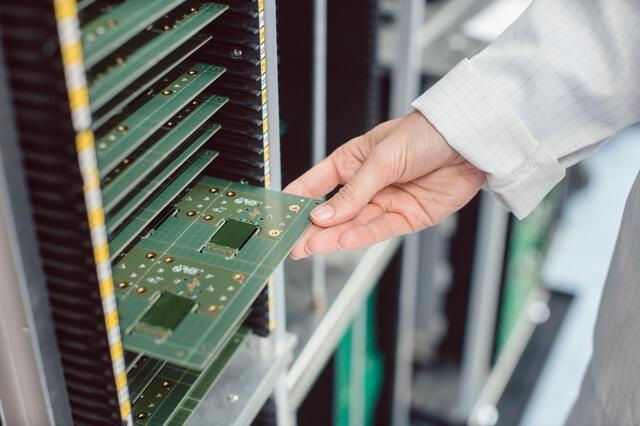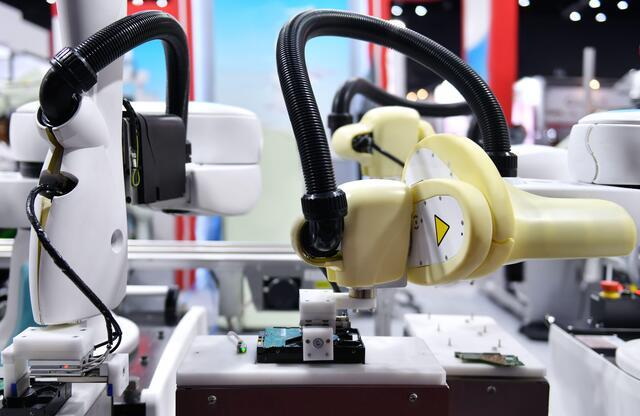Content Menu
● Understanding SMT Lines
>> Benefits of SMT Lines
● The One-Man Operation Model
>> Key Components of a One-Man Operation SMT Line
● Increasing Productivity
>> 1. Streamlined Processes
>> 2. Reduced Setup Times
>> 3. Enhanced Monitoring
>> 4. Flexibility in Production
● Reducing Costs
>> 1. Lower Labor Costs
>> 2. Decreased Material Waste
>> 3. Maintenance Savings
>> 4. Economies of Scale
● Challenges and Considerations
● Optimizing Efficiency in One-Man Operation SMT Lines
>> 1. Process Flow Optimization
>> 2. Advanced Training Programs
>> 3. Implementing Inline Inspection Systems
>> 4. Automating Material Handling Processes
● Case Studies Highlighting Success
● Conclusion
● FAQ
>> 1. What is an SMT line?
>> 2. How does automation improve productivity in an SMT line?
>> 3. What are the main advantages of using a one-man operation model?
>> 4. What challenges might arise from operating an SMT line with only one person?
>> 5. How can companies mitigate risks associated with a one-man operation SMT line?
● Citations:
The landscape of electronics manufacturing has evolved significantly with the advent of Surface Mount Technology (SMT). This technology has revolutionized the assembly of printed circuit boards (PCBs) by enabling higher efficiency, reduced costs, and improved product quality. One of the most intriguing developments in this field is the implementation of a one-man operation SMT line. This article delves into how such a setup can enhance productivity and lower costs while maintaining high standards of quality.

Understanding SMT Lines
SMT lines are specialized production systems designed for assembling electronic components onto PCBs. These lines utilize automated machinery to place components accurately and efficiently, minimizing human intervention. The automation involved in SMT processes allows for faster production cycles, reduced labor costs, and improved precision compared to traditional through-hole technology.
Benefits of SMT Lines
- Increased Efficiency: Automated machines can operate continuously, significantly increasing output rates.
- Reduced Labor Costs: With fewer operators needed, overall labor expenses decrease.
- Higher Quality Products: Automated processes reduce human error, leading to fewer defects.
- Space Optimization: SMT lines require less physical space due to their compact design and efficient workflows.
The One-Man Operation Model
The concept of a one-man operation SMT line involves equipping a single operator with the tools and technology necessary to manage the entire assembly process. This model leverages advanced automation to streamline operations, allowing one person to oversee multiple tasks that would typically require a team.
Key Components of a One-Man Operation SMT Line
1. Automated Pick-and-Place Machines: These machines are capable of quickly and accurately placing components onto PCBs at high speeds, often exceeding 100,000 parts per hour.
2. Reflow Ovens: Essential for soldering components to the board, reflow ovens ensure that solder paste melts and solidifies correctly, creating reliable electrical connections.
3. Automated Inspection Systems: Systems like Automated Optical Inspection (AOI) check for defects in real-time, allowing immediate corrections without halting production.
4. Material Management Systems: These systems automate inventory tracking and material replenishment, ensuring that the operator has everything needed without manual checks.
Increasing Productivity
A one-man operation SMT line can significantly boost productivity through several mechanisms:
1. Streamlined Processes
Automation minimizes the need for manual handling at various stages of production. Tasks such as component placement, soldering, and inspection can be executed rapidly and accurately by machines. This leads to shorter cycle times and faster turnaround for orders.
2. Reduced Setup Times
With advanced programming capabilities, modern SMT lines can switch between different product configurations with minimal downtime. Automated systems can pre-load settings based on the specific job requirements, allowing quick transitions between production runs.
3. Enhanced Monitoring
Real-time data collection from various stages of production allows for immediate adjustments to be made if issues arise. This proactive approach minimizes delays and maximizes operational efficiency.
4. Flexibility in Production
A one-man operation can easily adapt to changes in demand or product design without the need for extensive retraining or reconfiguration of the workforce. This flexibility is crucial in today's fast-paced electronics market.
Reducing Costs
Implementing a one-man operation SMT line not only boosts productivity but also contributes to significant cost savings:
1. Lower Labor Costs
By reducing the number of operators required on the line, companies can cut labor expenses dramatically. The savings from salaries, benefits, and training costs can be substantial.
2. Decreased Material Waste
Automated systems are programmed to optimize material usage, reducing waste associated with human error during assembly processes. This efficiency translates directly into cost savings on materials.
3. Maintenance Savings
With fewer machines operated by a single person, maintenance becomes easier to manage. Regular upkeep can be scheduled without disrupting a large team's workflow, leading to lower overall maintenance costs.
4. Economies of Scale
As production volumes increase, the cost per unit decreases due to fixed costs being spread over more products. A one-man operation can scale up production efficiently without significant increases in overhead costs.

Challenges and Considerations
While there are numerous benefits to a one-man operation SMT line, there are also challenges that must be addressed:
- Operator Skill Level: The success of this model relies heavily on having a highly skilled operator capable of managing complex machinery and troubleshooting issues as they arise.
- Initial Investment: The upfront cost of acquiring advanced automated equipment can be significant. However, this investment is often recouped through long-term savings in labor and material costs.
- Dependence on Technology: A heavy reliance on automated systems means that any technological failure could halt production entirely. It is crucial to have contingency plans in place for maintenance and repairs.
Optimizing Efficiency in One-Man Operation SMT Lines
To fully leverage the advantages of a one-man operation SMT line, manufacturers should focus on optimizing various aspects of their operations:
1. Process Flow Optimization
Reviewing and optimizing the process flow ensures that each step is necessary and efficient. Reasonable arrangement of component placement order and feeding methods maximizes placement speed and accuracy[2].
2. Advanced Training Programs
Investing in comprehensive training programs for operators enhances their skills in equipment operation, troubleshooting, and maintenance[10]. Well-trained operators can perform at optimal levels, reducing downtime and increasing quality.
3. Implementing Inline Inspection Systems
Inline inspection systems are designed to inspect PCBs as they exit the SMT machine using cameras and sensors[8]. This increases quality control while reducing manual inspection efforts from operators.
4. Automating Material Handling Processes
Automating component feeder changeovers and implementing material management systems streamline inventory processes[11]. This reduces manual intervention and improves overall production efficiency by ensuring that components are available when needed.
Case Studies Highlighting Success
Several companies have successfully implemented one-man operation SMT lines with remarkable results:
- Anda Technologies showcased its One-Man Operation solutions at industry expos, demonstrating how product flow input and output occur at the same location within the line[9]. This setup allows a single operator to load and unload PCB assemblies efficiently while reducing labor costs by up to 40%.
- A case study involving a Brazilian electronics factory implemented Single Minute Exchange of Die (SMED) methodology which reduced setup times by 64%[6]. This improvement led to increased productivity while utilizing fewer resources effectively.
Conclusion
The implementation of a one-man operation SMT line represents a significant advancement in electronics manufacturing efficiency and cost-effectiveness. By leveraging automation and streamlined processes, companies can achieve higher productivity levels while simultaneously reducing operational costs. As technology continues to evolve, these systems will likely become more prevalent in the industry, setting new standards for efficiency and quality in PCB assembly.

FAQ
1. What is an SMT line?
An SMT line is a specialized assembly line used for mounting electronic components onto printed circuit boards using Surface Mount Technology (SMT).
2. How does automation improve productivity in an SMT line?
Automation enhances productivity by increasing speed and accuracy in component placement while minimizing human error and reducing cycle times.
3. What are the main advantages of using a one-man operation model?
The primary advantages include reduced labor costs, increased flexibility in production, lower material waste, and streamlined processes that enhance overall efficiency.
4. What challenges might arise from operating an SMT line with only one person?
Challenges include ensuring that the operator is highly skilled, managing initial investment costs for advanced equipment, and addressing potential technological failures that could disrupt production.
5. How can companies mitigate risks associated with a one-man operation SMT line?
Companies can mitigate risks by investing in comprehensive training for operators, implementing regular maintenance schedules for equipment, and developing contingency plans for potential downtime scenarios.
Citations:
[1] https://www.pcbasic.com/blog/smt_production_line.html
[2] https://www.smtneoden.com/news/how-to-effectively-improve-the-production-efficiency-of-pcb-smt-machine/
[3] https://global.yamaha-motor.com/business/smt/concept/recipe/
[4] https://www.youtube.com/watch?v=2YferFPmNtI
[5] https://smttoday.com/2023/03/24/works-process-expert-optimization-along-the-entire-line/
[6] https://www.iosrjournals.org/iosr-jbm/papers/Vol25-issue3/Ser-3/G2503036078.pdf
[7] https://blog.matric.com/smt-production-for-pcbs-matric
[8] https://www.zjyingxing.com/info/what-are-the-ways-to-improve-the-efficiency-of-88896111.html
[9] https://smttoday.com/2022/10/05/one-man-operation-total-line-automated-coating-and-dispensing-solutions-by-anda-at-smtai/
[10] https://www.smtfactory.com/Optimizing-Efficiency-Strategies-for-A-Smooth-SMT-Line-Production-Process-id47463586.html
[11] https://www.criticalmanufacturing.com/blog/material-optimization-in-the-smt-and-electronics-assembly-industries/
[12] https://www.smtfactory.com/Perfecting-Your-SMT-Line-Layout-for-Efficiency-id47017676.html
[13] https://www.youtube.com/watch?v=_oJk3p6m-I0
[14] https://www.microtype.io/should-you-buy-a-pick-and-place-machine/
[15] https://core-emt.com/blog/smt-news-1/how-to-boost-placement-productivity-87
[16] https://www.researchgate.net/publication/312573374_Measuring_machine-group_flexibility_a_case_study_for_surface_mount_assembly_line_with_different_configurations
[17] https://www.protoexpress.com/blog/good-not-so-good-sides-surface-mount-technology/
[18] https://www.researchgate.net/publication/369741946_An_Automatic_Assembly_SMT_Production_Line_Operation_Technological_Process_Simulation_Model_Development
[19] https://www.camline.com/line-controller-as-collaborative-agent-to-orchestrate-processes-and-taking-automation-to-the-next-level/
[20] https://www.allion.com/tech_surface_mount_tech/
[21] https://papers.ssrn.com/sol3/papers.cfm?abstract_id=4633194




















